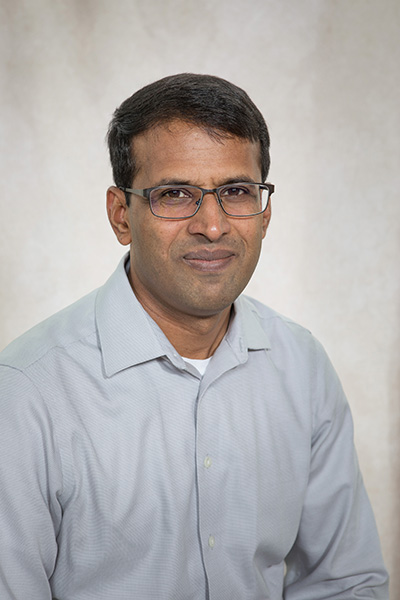- Apply
- Visit
- Request Info
- Give



Published on April 06, 2021

Vijaykumar Veerappan, assistant professor of biology at Eastern Connecticut State University, gave new meaning to the phrase “Seeing is Believing” during his virtual presentation, “Genetics and Art,” on April 1.
His presentation, made in collaboration with Eastern’s Art Gallery, was part of the gallery exhibition “Precision: Illustrative Technique in Art and Science.” The exhibition, which runs through April 25, brings together 16 artists who are inspired by one goal — to explain scientific facts through evocative visual language.
Veerappan spoke on the importance of art in genetics, and biology in general – how illustration techniques may lend critical insight and aesthetic enjoyment of molecular and genetic mechanisms.
Veerappan said generally when one discusses genetics, it is a complex subject matter, but that joined together with beautiful art, can help students understand how the broken parts of genetics work together. In short, the scientific truth of the existence of a DNA occurrence, as seen through an artistic lens, can no longer be doubted. Seeing really is believing.
“Art it is an essential part of genetics and biology in general. Different art forms, including photography, illustrations and animations, can capture the intricate details in biology and simplify complex concepts into simple parts so that it is easy to understand.”
Veerappan said what’s most exciting is that probed together, art illustrations and animations make science exciting and fun-filled. “Art can actively engage mind and body and can make learning difficult concepts aesthetically pleasing by taking away the boredom, and render knowledge about scientific challenges more enjoyable to learn. Artistic expression of biology can also be an effective tool for scientists to communicate with the public to educate them about important scientific topics.”
Veerappan used an illustration of COVID-19 — that familiar grey, round circle with red spikes on it — which attaches itself to and infects human cells. He said the public could not imagine what the virus looks like unless it had been enlarged more than 100,000 times through an electron microscope. He said without the illustration, no one would understand the virus, how it develops and invades cells.
“Enlarged and illustrated, the public can distinguish the different parts of the virus,” said Veerappan. “Without the illustration, we don’t understand the aspects of the virus. With a visualization, the public can see the spikes, the various protein parts of the virus. Doctors and scientists can describe and study the moving parts. Clearly, art comes into play in providing clarity to this deadly virus.”
Historical perspective helped to boost Veerappan’s case. Using the painting “Virgin and Child” by Andrea Mantegna and Rembrandt’s “The Anatomy Lesson,” Veerappan said, “If we don’t have paintings, we don’t have historical records. Sculpture and other art forms help to actively engage mind and body and educate the public about science. It’s no different with science and genetics.”
Veerappan showed slides allowing the audience to visualize human chromosomes, DNA and mutants. He said the illustrations and animations show how each part of DNA is packaged. The slides showed how DNA is the blueprint of life, and why we look like our parents.
Veerappan has spent the past 20 years in plant genetics research, discovering genes and using plant mutants as a tool that can potentially improve agriculture. He concluded his remarks by saying he sees tremendous value in teaching that genetics is art, as art helps students understand the complicated parts of genetics.
“Many people don’t read and understand this subject well. I require my students to learn by drawing pictures of cells or scanning and using Photoshop to perhaps create their own videos. Genetics truly is an art!”
The Art Gallery is open to the public and located in the Fine Arts Instructional Center. Admission is free during gallery hours: Monday-Friday, 9 a.m.-6 p.m., or by appointment. For more information, call (860) 465-4625 or email tikhonovay@easternct.edu.Written by Dwight Bachman